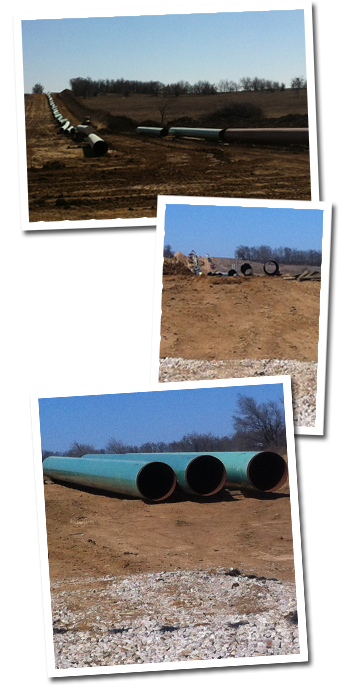A Pipeline And Your Property

When a company tells you that they want to put a pipeline on your land, it is crucial to know whether that company has a “right” to do so. What is that right and where is it derived from? A good pipeline attorney can help.
Initially that “right” usually starts from another legal right, like the right of eminent domain (the right to condemn your property) or certain rights under an oil and gas lease. But sometimes a company does not have either of those rights.
It’s been our experience at the LandownerFirm, that companies use the threat of litigation, under either their lease rights or eminent domain rights, to get landowners to sign away more than they should. They are successful because landowners fear the courthouse. But we don’t. Our pipline lawyers at the LandownerFirm are experienced trial attorneys fighting for the rights of farmers, ranchers, and small and mid-sized business clients.
Without an attorney on their side, landowner signs away rights that the company would not get if the matter went to court. Arriving at a contractual agreement by negotiations is cleaner for the company and offers more protections for the property owner.
Contact the LandownerFirm at 888-439-4729 to talk with a lawyer about your situation.
Understanding the Legal Framework for Placing a Pipeline
Here we will discuss (a) rights under an oil and gas lease, (b) rights under eminent domain, (c) and contracts or surface use agreements.
(a) Under an oil and gas lease a company has a right to lay the line within the unit to transport materials within that unit from that unit. Typically this is not enough and the company wants more so they need the landowner to sign a contract.
It has been our experience that these rights are not clearly explained and the landowner is left thinking they have no choice but to sign. This simply is not the case. In all reality, the landowner doesn’t have to sign anything and the company would still have to pay damages.
(b) If a company is transporting for interstate or intrastate commerce and they are defined as a common carrier, the company will usually be able to get the right of eminent domain from a state constitution or the federal constitution.
It is crucial to the negotiation process to realize that the rights granted from a condemnation case may not be all the company wants. For example, the company may want the right to run gas AND oil through a line, but their present use is only for oil. However, they will only be able to condemn for an oil pipeline. Here again, they need a contract to do what they want.
Note: It has been our experience that companies use the threat of their right to litigate under either their lease rights or eminent domain rights to get landowners to sign away more than they should because the landowner fears the courthouse. The result is the landowner signs away rights contractually that the company would not get if the matter proceeded to conclusion at the courthouse.
(c) When negotiating contractual rights with a company it is important to make the negotiations bilateral so that the landowner gets a good surface use agreement as part of the easement/row/release/contract, whatever it may be. Sometimes the company will not have any rights under (a) or (b) so they have to negotiate. Under this scenario the landowner has more power.

Many times those negotiating on behalf of a company will say they have rights under (a) or (b) when they actually don’t. Essentially, companies use independent contractors to scare landowner into signing a contract that they don’t have to sign.
Don’t Be Misled
Just like other types of negotiations, landowners are prone to falling into the trap of looking for the most money and failing to focus on the contract. Landowners, and sometimes their non-landowner lawyers, fail to consider all of the issues that could arise, like remediation, subsurface easements, roads, non-unit transportation rights, noise pollution etc. The trend is toward surface use agreements that contain contractual rights for the company as opposed to what was historically called a blanket easement or right-of-way. Blanket easements and right-of-way’s are rarely done in this day and age when landowners are better educated about their rights.
At the LandownerFirm we believe the proper course of action is to focus on the contract by attempting to negotiate a good surface use agreement that is fair to both parties. A good surface use agreement will:
- Clearly set out each party’s rights,
- Define and limit the scope of the release,
- Define all terms. and
- Be executed by both parties.
Surface use agreements are becoming more prevalent as companies seek rights they can’t get any other way than through contract negotiations.
Not only are the LandownerFirm attorneys well versed in the negotiation of surface use agreements, we also regularly litigate eminent domain and lease right cases in the jurisdictions where we practice. We try cases when necessary, but usually we prepare our cases so well that companies rarely force our clients into the courtroom. They typically agree to good surface use agreements and fair compensation for the landowners we represent.
Contact a Pipeline Attorney
Contact our law firm to schedule a consultation at our Tulsa Metro (Bixby), Oklahoma City, or Coalgate office, or call 888-439-4729. We’re here to protect your interests.
